Haldane discussed the prevalence of stars and beetles in his book “What is life?” published in the 1940s;
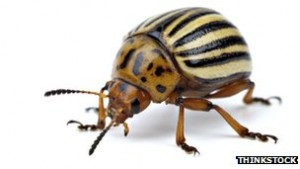 “The Creator would appear as endowed with a passion for stars, on the one hand, and for beetles on the other, for the simple reason that there are nearly 300,000 species of beetle known, and perhaps more, as compared with somewhat less than 9,000 species of birds and a little over 10,000 species of mammals. Beetles are actually more numerous than the species of any other insect order. That kind of thing is characteristic of nature.”
“The Creator would appear as endowed with a passion for stars, on the one hand, and for beetles on the other, for the simple reason that there are nearly 300,000 species of beetle known, and perhaps more, as compared with somewhat less than 9,000 species of birds and a little over 10,000 species of mammals. Beetles are actually more numerous than the species of any other insect order. That kind of thing is characteristic of nature.”
One among the 300,000 species is Colorado potato beetle. An adult beetle is around 10mm long and is orange or yellow with black or brown stripes. The beetle’s main food is potato leaves – a single larva can eat 40 sq cm of leaf per day.
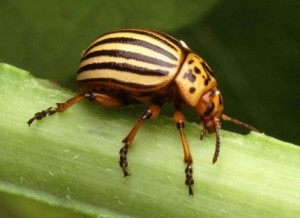 The pretty yellow-and-black-striped Colorado potato beetle is native to wild Solanaceous plants of the semi-arid western United States. Colorado beetles are a serious pest of potatoes.. Both adults and larvae feed on foliage and may skeletonize the crop. . The problem with it began when the beetle broadened its gustatory interests to include cultivated plants in the same family, such as potato, eggplant, and tomato.
The pretty yellow-and-black-striped Colorado potato beetle is native to wild Solanaceous plants of the semi-arid western United States. Colorado beetles are a serious pest of potatoes.. Both adults and larvae feed on foliage and may skeletonize the crop. . The problem with it began when the beetle broadened its gustatory interests to include cultivated plants in the same family, such as potato, eggplant, and tomato.
Going through the life cycle of the Colorado potato beetle, in late summer, Colorado potato beetles fly to nearby wooded areas and overwinter beneath bark or other cover. In mid-spring, they emerge and walk until they find potatoes or another suitable host plant. After a little light feeding, mated females lay clusters of orange eggs on leaf undersides. The eggs hatch about two weeks later, and the larvae feed for a couple of weeks before entering their pupal stage. In cool weather the entire life cycle can take 45 days or more, but 30 days is more typical. This means that a second generation can emerge at the perfect time to sabotage midseason potatoes.
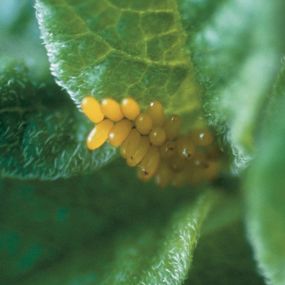 Colorado potato beetle causes heavy monetary damages. The article named “Last Meal for Colorado potato beetle?” in USA Agriculture department gives the estimate of the economic loss due to the species, “The pest’s larvae devour the leaves of eggplant, tomato and potato plants, causing $150 million annually in crop losses and chemical control expenses”
Colorado potato beetle causes heavy monetary damages. The article named “Last Meal for Colorado potato beetle?” in USA Agriculture department gives the estimate of the economic loss due to the species, “The pest’s larvae devour the leaves of eggplant, tomato and potato plants, causing $150 million annually in crop losses and chemical control expenses”
The problem of Colorado potato beetle is mentioned in yet another article,
Some Growers Say Potato Beetle Becoming Intractable Problem
Anecdotal evidence suggests the Colorado potato beetle has increased its range in Estonia, and some farmers say the situation is dire, especially as the state declassified the colorful bug as a dangerous pest in 2011.
With potato fields flowering, ETV reported on one Saaremaa island field where the beetle had not been seen before, but which is experiencing a major infestation.
Officially, the farmers are advised to manually pluck the larvae and repeat every day, and only resort to pesticides for larger infestations.
There are some areas of Saaremaa where the beetle is well-established and can’t 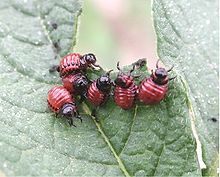 apparently be eradicated, farmers said.
apparently be eradicated, farmers said.
Aadu Grepp, one farmer, said that beetles could be found on every fourth or fifth stalk in his fields.
“You have to spray with some toxin at the right time to get rid of it. In a couple days, it will eat a plant, leaving just a stalk.” He said it had been that bad for two or three years. “The bug hatches from the soil and and there’s nothing to do, the only cure is chemicals. There’s so many and it will return in a week or so.”
Grepp sprays his fields several times a year and said some Leisi growers had stopped planting potatoes.
The areas on Saaremaa affected tend to be on the coasts, as the adult beetle gets an assist from the wind. The biggest potato grower on the island, Guido Lindmäe, who has 22 hectares in the interior, says he yet to see a live beetle.
Opinions vary on whether the mainland is worse off. The Crop Research Institute’s Luule Tartlan says it is worse, while the Agricultural Board says that the potato beetle has ceased to be considered a dangerous pest as of 2011.
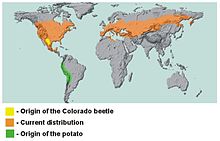 The Colorado potato beetle have shifted from its original wild hosts in southwestern North America, it has spread throughout the rest of the continent and has invaded Europe and Asia. Currently its distribution covers approximately 14 million km2 around the world. It has also started appearing in central Asia, western China and Iran. They have started appearing in new regions because of heavy export from the infected area.
The Colorado potato beetle have shifted from its original wild hosts in southwestern North America, it has spread throughout the rest of the continent and has invaded Europe and Asia. Currently its distribution covers approximately 14 million km2 around the world. It has also started appearing in central Asia, western China and Iran. They have started appearing in new regions because of heavy export from the infected area.
Insecticides are currently the main method of beetle control on commercial 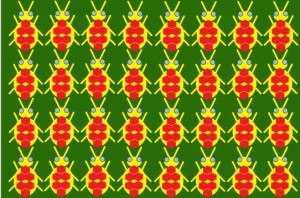 farms.Colorado potato beetle has a legendary ability to develop resistance to a wide range of pesticides used for its control. Plants in the family Solanaceae, which are natural food sources for this insect, have high concentrations of rather toxic glycoalkaloids in their foliage. These toxins protect them from a wide range of herbivores. However, the Colorado potato beetles evolved an ability to overcome toxic defenses of its hosts. Apparently, this ability also allows them to adapt to a wide range of human-made poisons. Also, high beetle fecundity increases the probability that one of the numerous offspring mutates, just as buying 800 lottery tickets increases probability of getting a winning one compared to buying 8 lottery tickets.
farms.Colorado potato beetle has a legendary ability to develop resistance to a wide range of pesticides used for its control. Plants in the family Solanaceae, which are natural food sources for this insect, have high concentrations of rather toxic glycoalkaloids in their foliage. These toxins protect them from a wide range of herbivores. However, the Colorado potato beetles evolved an ability to overcome toxic defenses of its hosts. Apparently, this ability also allows them to adapt to a wide range of human-made poisons. Also, high beetle fecundity increases the probability that one of the numerous offspring mutates, just as buying 800 lottery tickets increases probability of getting a winning one compared to buying 8 lottery tickets.
Resistance mechanisms in the Colorado potato beetle are highly diverse even within a relatively narrow geographical area. Furthermore, the beetles show cross-resistance to organophosphates and carbamates, and multiple resistance to organophosphates, carbamates, and pyrethroids.
The immune powers of Colorado potato beetle have forced humans to look for solutions above the hazardous insecticides.
Hence to help alleviate or else completely eradicate the infestation we C Tech Corporation provide you with the best effective solution Combirepel™.Combirepel™ is an anti-insect aversive developed on the grounds of green chemistry and technology.
Our product works on the mechanism of repellency. It temporarily inhibits the mating cycle of the insects. The product impairs the ability of the insects to reproduce, that is the insects will not lay eggs or the laid eggs will be infertile. The product causes feeding disruption in an insect by triggering an unpleasant reaction within the insect which might try to feed on the application. The product temporarily blocks the reproduction system of the insects by hindering the release of the vital hormones for growth.
Combirepel™ is thermally stable and does not degrade on exposure to heat and sunlight. It does not kill or harm the insect but repels them. It does not volatilize and does not degrade the soil. It is RoHS, RoHS2, ISO, REACH, APVMA, NEA compliant and FIFRA exempted.
Combirepel™ is an eco-friendly product which acts as an aversive to repel the pesky insects like roaches. Combirepel™ do not kill the targeted as well as non-targeted species but just repel them causing no harm no to human and environment.
Combirepel™ is available in the form of masterbatch, liquid concentrate, and lacquer. Our Combirepel™ masterbatch can be used in polymer base applications like wires, cables, irrigation pipes, polymeric vessels, and other various applications.
Combirepel™ liquid concentrate can be mixed in the paints to cover the areas like cracks and crevices of walls and hidden places where the roaches tend to survive.
Combirepel™ lacquer is the topical coating to cover the places like bathrooms, cupboards, steam tunnels, etc.
Hence we provide you with the best effective solution.
Contact us as technical.marketing@ctechcorporation.com to get solution on pest nuisance.
Also, visit our websites:
http://www.ctechcorporation.com/
http://www.rodrepel.com/
http://www.termirepel.com/
http://www.combirepel.com/
Follow our Facebook pages at:
1] https://www.facebook.com/Combirepel-411710912249274/
2] https://www.facebook.com/Termirepel-104225413091251/
3] https://www.facebook.com/Rodrepel-120734974768048/
Follow us on our Twitter pages at:
1] https://twitter.com/rodrepel
2] https://twitter.com/termirepel
3] https://twitter.com/combirepel
